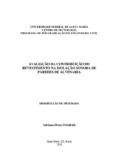| dc.creator | Friedrich, Adriana Flores | |
| dc.date.accessioned | 2010-08-04 | |
| dc.date.available | 2010-08-04 | |
| dc.date.issued | 2010-03-25 | |
| dc.identifier.citation | FRIEDRICH, Adriana Flores. COATING CONTRIBUTION ON THE ACOUSTIC PERFORMANCE OF
MASONRY WALLS. 2010. 123 f. Dissertação (Mestrado em Engenharia Civil) - Universidade Federal de Santa Maria, Santa Maria, 2010. | por |
| dc.identifier.uri | http://repositorio.ufsm.br/handle/1/7748 | |
| dc.description.abstract | The research presents the sound insulation in masonry walls coated with plaster. Three walls were built in laboratory, studied in specific tests. Measurements were carried out varying some components of the wall, such as the type of the block and the combinations of coarse mortar, plaster and stucco on the faces of the wall. The mortars used in the tests were industrialized and had an additive in their conglomerate that aimed to its structural and commercial improvement. Also, paints and textures were used alternately in the tests to verify
the importance of this kind of coating on the sound transmission loss of the wall. The laboratory findings showed up the location of the coincidence frequency and the acoustic accomplishment of the coated masonry walls. Variation of these factors had a direct influence at the system hardness. The increase of the variation in the set caused by the addition of the mortar layers does vary, further of frequency of coincidence, the frequency of resonance wall thickness. It was still checked that three days of drying of the mortar was sufficient to have
satisfactory results on the essays. The laboratory tests brought more agility with the evidence and the validation that the cure of the aggregate in the wall needs three days. Another important verification was the increase of 5 dB on the Weighted Noise Reduction Index (Rw) when the wall is coated in both faces. The using of paint and texture didn t contribute to the acoustic performance of the wall. Just, the utilization of texture shown a raise of acoustic performance of 1 dB on the Weighted Noise Reduction Index (Rw). That didn t happend with the duplication of the layer of plaster, that obtained acoustic insulation indicators lower than 1dB in the set. | eng |
| dc.description.sponsorship | Coordenação de Aperfeiçoamento de Pessoal de Nível Superior | |
| dc.format | application/pdf | por |
| dc.language | por | por |
| dc.publisher | Universidade Federal de Santa Maria | por |
| dc.rights | Acesso Aberto | por |
| dc.subject | Acústica arquitetônica | por |
| dc.subject | Perda de transmissão sonora | por |
| dc.subject | Revestimento | por |
| dc.subject | Architectural acoustics | eng |
| dc.subject | Transmission Loss | eng |
| dc.subject | Coating | eng |
| dc.title | Avaliação da contribuição do revestimento na
isolação sonora de paredes de alvenaria | por |
| dc.title.alternative | Coating contribution on the acoustic performance of
masonry walls | eng |
| dc.type | Dissertação | por |
| dc.description.resumo | A pesquisa investigou a maneira como acontece a isolação sonora em paredes de alvenaria estrutural com revestimento de argamassa. Foram construídas em laboratório três paredes, estudadas em ensaios específicos. O tipo do bloco e as combinações de chapisco, emboço e reboco foram avaliados alternadamente em cada bateria de ensaios. As argamassas utilizadas nos ensaios eram industrializadas e possuíam aditivos em seu conglomerado que visavam a sua melhora estrutural e comercial. Também, foram utilizadas tintas e texturas alternadamente nos ensaios para verificar a
influência deste tipo de acabamento na perda de transmissão sonora da parede. As constatações laboratoriais mostraram a localização da frequência de coincidência e o desempenho acústico das paredes de alvenaria estrutural revestidas. A variação desses fatores possui influência direta conforme
a rigidez do sistema. O seu aumento no conjunto causado pelo acréscimo de camadas de argamassa faz variar, além da frequência de coincidência, também a frequência de ressonância de espessura da parede. Aferiu-se, ainda, a possibilidade de diminuição dos dias de secagem da argamassa entre os ensaios realizados. Os testes em laboratório ganharam em agilidade, com a comprovação e validação
do tempo de 3 dias para a cura da massa usada na parede. Outra importante verificação foi o incremento de 5 dB no Índice de Redução Sonora Ponderado (Rw) quando há o revestimento da parede em ambas as faces. A utilização de tinta e de textura não acrescentou ganhos acústicos
substanciais para o conjunto da parede. Apenas, a utilização da textura apresentou um aumento de performance na ordem de 1 dB no índice de redução sonora ponderado (Rw). O que não aconteceu com a duplicação da camada de reboco, que obteve indicadores de isolação sonora inferiores a 1 dB no
conjunto. | por |
| dc.contributor.advisor1 | Paixão, Dinara Xavier da | |
| dc.contributor.advisor1Lattes | http://buscatextual.cnpq.br/buscatextual/visualizacv.do?id=K4794800H9 | por |
| dc.contributor.advisor-co1 | Miranda, Erasmo Felipe Vergara | |
| dc.contributor.advisor-co1Lattes | http://lattes.cnpq.br/1682598720803230 | por |
| dc.contributor.referee1 | Pinheiro, Marco Antônio Silva | |
| dc.contributor.referee1Lattes | http://buscatextual.cnpq.br/buscatextual/visualizacv.do?id=K4796909Y2 | por |
| dc.contributor.referee2 | Vasconcellos, João Gualberto Moreira | |
| dc.contributor.referee2Lattes | http://buscatextual.cnpq.br/buscatextual/visualizacv.do?id=K4781274H4 | por |
| dc.creator.Lattes | http://buscatextual.cnpq.br/buscatextual/visualizacv.do?id=K4744673A8 | por |
| dc.publisher.country | BR | por |
| dc.publisher.department | Engenharia Civil | por |
| dc.publisher.initials | UFSM | por |
| dc.publisher.program | Programa de Pós-Graduação em Engenharia Civil | por |
| dc.subject.cnpq | CNPQ::ENGENHARIAS::ENGENHARIA CIVIL | por |


